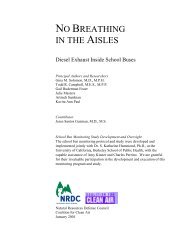US Nuclear Weapons in Europe - Natural Resources Defense Council
US Nuclear Weapons in Europe - Natural Resources Defense Council
US Nuclear Weapons in Europe - Natural Resources Defense Council
You also want an ePaper? Increase the reach of your titles
YUMPU automatically turns print PDFs into web optimized ePapers that Google loves.
U.S. <strong>Nuclear</strong> <strong>Weapons</strong> <strong>in</strong> <strong>Europe</strong> • Hans M. Kristensen/<strong>Natural</strong> <strong>Resources</strong> <strong>Defense</strong> <strong>Council</strong>, 2005<br />
After the terrorist attacks on September 11, 2001, the U.S. government has changed the<br />
way it views security of its nuclear weapons. Prior to 2001, the nuclear weapons security<br />
philosophy was based on the premise that “people would try to steal them,” accord<strong>in</strong>g to<br />
National <strong>Nuclear</strong> Security Adm<strong>in</strong>istration (NNSA) Director L<strong>in</strong>ton Brooks. But now it is<br />
obvious that there are <strong>in</strong>dividuals who are will<strong>in</strong>g to sacrifice their lives just to create a<br />
nuclear <strong>in</strong>cident, he said. As a result, NNSA has expanded its security perimeters so that<br />
potential attackers can be stopped farther away from a nuclear facility. 227<br />
In the case of the nuclear weapons deployed <strong>in</strong> <strong>Europe</strong>, however, the aircraft shelters that<br />
store the weapons are dispersed across eight different bases <strong>in</strong> six countries. In many<br />
cases, the shelters are located only a few hundred meters or less from the fence<br />
surround<strong>in</strong>g the base (see Appendix C). The idea of dispers<strong>in</strong>g the weapons to shelters<br />
across the bases <strong>in</strong>stead of storage <strong>in</strong> a central <strong>Weapons</strong> Storage Area at each base<br />
emerged <strong>in</strong> the 1970s as a way of ensur<strong>in</strong>g survival of nuclear weapons <strong>in</strong> case of a<br />
Soviet surprise attack. With the Soviet threat gone, however, the assessment of security<br />
of nuclear weapons on forward locations must be based on the threats that exist today.<br />
The question is whether the vague and nonessential role that U.S. forward-deployed<br />
nuclear weapons <strong>in</strong> <strong>Europe</strong> play today can any longer be argued to outweigh the potential<br />
consequences of a successful terrorist attack – no matter how theoretical that may be.<br />
Withdraw<strong>in</strong>g the rema<strong>in</strong><strong>in</strong>g U.S. nuclear weapons from <strong>Europe</strong> would alleviate that<br />
unnecessary risk, f<strong>in</strong>ish the withdrawal process that was begun <strong>in</strong> 1991 but which has<br />
been dormant for a decade, and enable NATO to focus on the security challenges that are<br />
relevant for the future. Perhaps changes might be possible under the current U.S. global<br />
posture decision and the impend<strong>in</strong>g Base Realignment and Closure (BRAC) process.<br />
The most compell<strong>in</strong>g opportunity to end the forward deployment of nuclear weapons <strong>in</strong><br />
<strong>Europe</strong> may be the announcement by NATO that it has reduced the read<strong>in</strong>ess level of the<br />
aircraft that are <strong>in</strong>tended to delivery the U.S. nuclear bombs to “months.” The very low<br />
read<strong>in</strong>ess level suggests that the electronic and mechanical <strong>in</strong>terfaces that enable the<br />
aircraft to carry and deliver the nuclear bombs may have been dismantled and placed <strong>in</strong><br />
storage. S<strong>in</strong>ce tra<strong>in</strong><strong>in</strong>g at nuclear bases does not require live nuclear weapons but is done<br />
with “dummy” weapons, such a low read<strong>in</strong>ess level calls <strong>in</strong>to question the need to<br />
cont<strong>in</strong>ue to forward deploy U.S. nuclear weapons <strong>in</strong> <strong>Europe</strong> because it allows for plenty<br />
of time to transfer the weapons <strong>in</strong> a crisis if needed.<br />
The need for these weapons is rapidly erod<strong>in</strong>g. While NATO still talks about their<br />
unique contribution to the alliance, the U.S. <strong>Defense</strong> Science Board Task Force on Future<br />
Strategic Strike Forces recommended <strong>in</strong> February 2004 that the nuclear capability of the<br />
forward-based, tactical, dual-capable aircraft should be elim<strong>in</strong>ated because there is “no<br />
obvious military need for these systems….” 228 Because the use of nuclear weapons <strong>in</strong> a<br />
conflict could provoke serious political, economic, military, and environmental<br />
consequences, accord<strong>in</strong>g to the latest U.S. Doctr<strong>in</strong>e for Jo<strong>in</strong>t <strong>Nuclear</strong> Operations, “allied<br />
as well as adversary understand<strong>in</strong>g of <strong>US</strong> nuclear weapon policy is essential.” 229 Yet the<br />
vague and unspecific role attributed by NATO to the weapons <strong>in</strong> <strong>Europe</strong> suggests that the<br />
alliance – and therefore also potential adversaries – is uncerta<strong>in</strong> about the exact role.<br />
73
















